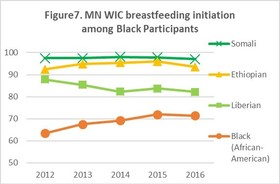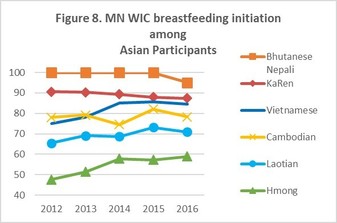|
August 2018
August is Breastfeeding Awareness Month, and World Breastfeeding Week is held August 1-7 each year.
“Given the importance of breastfeeding on the health of
mothers and children, it is critical that we take action to support
breastfeeding. Women who choose to breastfeed face numerous barriers—only
through the support of family, communities, clinicians, healthcare systems, and
employers will we be able to make breastfeeding the easy choice.” Jerome
M. Adams, MD, MPH U.S. Surgeon General
At the Minnesota Department of Health, the Minnesota Special
Supplemental Nutrition Program for Women, Infants & Children (MN WIC) and
the Office of Vital Records (OVR) work together toward the ultimate goal of
improving the public's health. The WIC program promotes and supports
breastfeeding to improve maternal and infant health and strives to reduce
disparities by using birth record and other data to design culturally
appropriate services tailored to participants’ specific needs.
In the WIC Program, data on race/ethnicity is self-reported
by participants, based on standard race/ethnicity categories mandated by the
federal Office of Management and Budget (OMB): Hispanic/non-Hispanic: American
Indian, White, Black, Asian, and/or Native Hawai’ian/Pacific Islander. These
standard categories are not sufficient to understand the communities served by
WIC. In 2015, some local WIC agencies began asking Black and Asian participants
to name a cultural identity in addition to race. In addition, MN WIC started linking
birth record data with WIC data to obtain more information on participants’
cultural identity and nativity (U.S.-born or foreign-born).
Having health information by cultural identity on indicators
such as anemia, breastfeeding, weight status and birth outcomes has enabled MN
WIC to better identify high-risk populations so that WIC services can be
tailored to the needs of WIC participants. Evaluating WIC
participant data by cultural identity enriches our understanding of differing
health outcomes and allows us to target our services more effectively.
For example, local WIC agencies observed less breastfeeding
among U.S.-born African-American women than among African immigrant women. Acquiring
data on cultural identity has allowed WIC to quantify these differences in
breastfeeding behaviors in different communities.

In Hennepin County, nearly half of black mothers identify
with an African culture. The high breastfeeding rates among these mothers was
masking the fact that many African-American mothers were struggling with
breastfeeding. While WIC staff observed some differences, quantifying this
disparity was the first step towards addressing it. WIC has increased its number of breastfeeding
peer counselors from local African–American communities. With the
differentiated data, WIC will be able to track progress in these communities
over time.
To improve breastfeeding rates, WIC uses birth record and
WIC data to
- Identify priority groups and contributing
factors
- Understand cultural practices that may put
families at risk, such as beliefs about pumped milk or religious fasting which
can impact milk supply
- Create targeted education for families on
infant feeding practices and long-term effects of breastfeeding and exclusive
breastfeeding.
|

Another example of cultural disparities in breastfeeding is
the widely differing practices in various Asian communities. MN WIC Hmong
participants (the largest group of Asian participants in WIC), were
historically grouped together with all other Asian participants, including
Vietnamese, Cambodian, Laotian, KaRen, and Bhutanese-Nepali. Each of these
cultures has its own traditions and feeding practices.
Higher breastfeeding rates in other Asian groups masked low
rates in the Hmong community. Utilization of birth record data has allowed MN WIC
to differentiate between these groups.
In many communities, acculturation leads to lower
breastfeeding rates over time. Birth record data allowed WIC to see that
second-generation Hmong have higher rates of breastfeeding initiation than new
Hmong immigrants do, but that their rates are still lower than other Asian
cultural groups.
The linking of WIC and birth record data provides a fuller
picture of breastfeeding behaviors. The birth record includes information on birthing
facility and breastfeeding initiation, while the WIC data provides information
on breastfeeding duration. WIC has collected some data on the use of formula during
the hospital stay, but other than that, there is currently no good source of
information on exclusive breastfeeding.
The availability of this data, and measuring trends over
time, will help identify these and other communities in need of education and
support.
For more information, see Breastfeeding
in Minnesota’s WIC Program Fact Sheet 2018
Additional resources available
for mothers and professionals:
The Office of
Statewide Health Improvement Initiatives (OSHII) provides information
to support mothers and the professionals who care for them.
The
Minnesota Breastfeeding Coalition
works to create an environment in Minnesota where breastfeeding is recognized
and supported as vital to the health and development of children and families.
The
Centers for Disease Control and Prevention (CDC)
provides guidelines and recommendations about breastfeeding.
|

In February this year, the Office of Vital Records reorganized
into four units that focus on operational functions: Security and Records, the
Registrar’s Office, Registration and Fulfillment and Statewide System &
Application Support (SSAS). Bill Devine joined OVR as the supervisor of the SSAS
unit in late July 2018.
OVR staff who work on data quality, performance, education
and awareness, MR&C technical support, and constituent and partner support
including the OVR Customer Service Desk are part of the SSAS unit.
The unit is focusing on the education and support of vital
records stakeholders so that customers can obtain the documents they need, and
accurate data is reported to other states and the National Center for Health
Statistics. Vital records stakeholders include local county registrars and staff, morticians and
staff, medical certifiers, other health care providers, hospitals and birth facilities.
Bill commented: “My goal is to support the team as much as
possible so that they can succeed in their roles. I want to create a positive,
respectful environment that allows each team member to gain strength and
expertise. I want to find or create the tools that the team needs to support
the team’s goals going forward.”
When he is not at work, Bill likes working in his yard,
volunteering for pit bull rescue groups, supporting organizations in the LGBTQ
community, and spending time with Nigel, his rescued American Bulldog/American Pit
Bull mix.
Before coming to the Office of Vital Records, Bill Devine
worked in the health insurance industry for 12 years with roles in compliance,
credentialing, audit and regulatory review. He also worked in the tech industry
at Lawson Software and, before that, in film and TV production.
|

The National Association for Public Health Statistics and
Information Systems (NAPHSIS), the professional membership organization for
vital records and vital statistics programs, is hosting its first-ever Identity
& Security Conference in Washington D.C., November 15 and 16, 2018.
The pace of technological change has quickened. This
conference will provide an opportunity for a national conversation on the
rapidly changing intersection of identity and security, as related to vital
records. Participants will learn about new trends in fraud prevention, secure
data exchange services, biometrics, and identity management, among other
topics.
The Office of Vital Records encourages managers, supervisors,
and staff at county vital records offices to consider the event. “You are the
frontline securing Minnesota records and identities,” said Molly Crawford,
State Registrar. “This event is aimed at vital records professionals who issue
certificates and check identification. This is a great professional development
opportunity that puts you in touch with others across the country and in the
industry who face the same challenges as you do.”
For program tracks, registration and hotel information, see 2018
Identity & Security Conference.
A new issue of Minnesota VitalSigns, published in July 2018 by the Minnesota
Center for Health Statistics,
features “Source
of Payment Information from the Minnesota Birth Certificate (PDF)”.
|